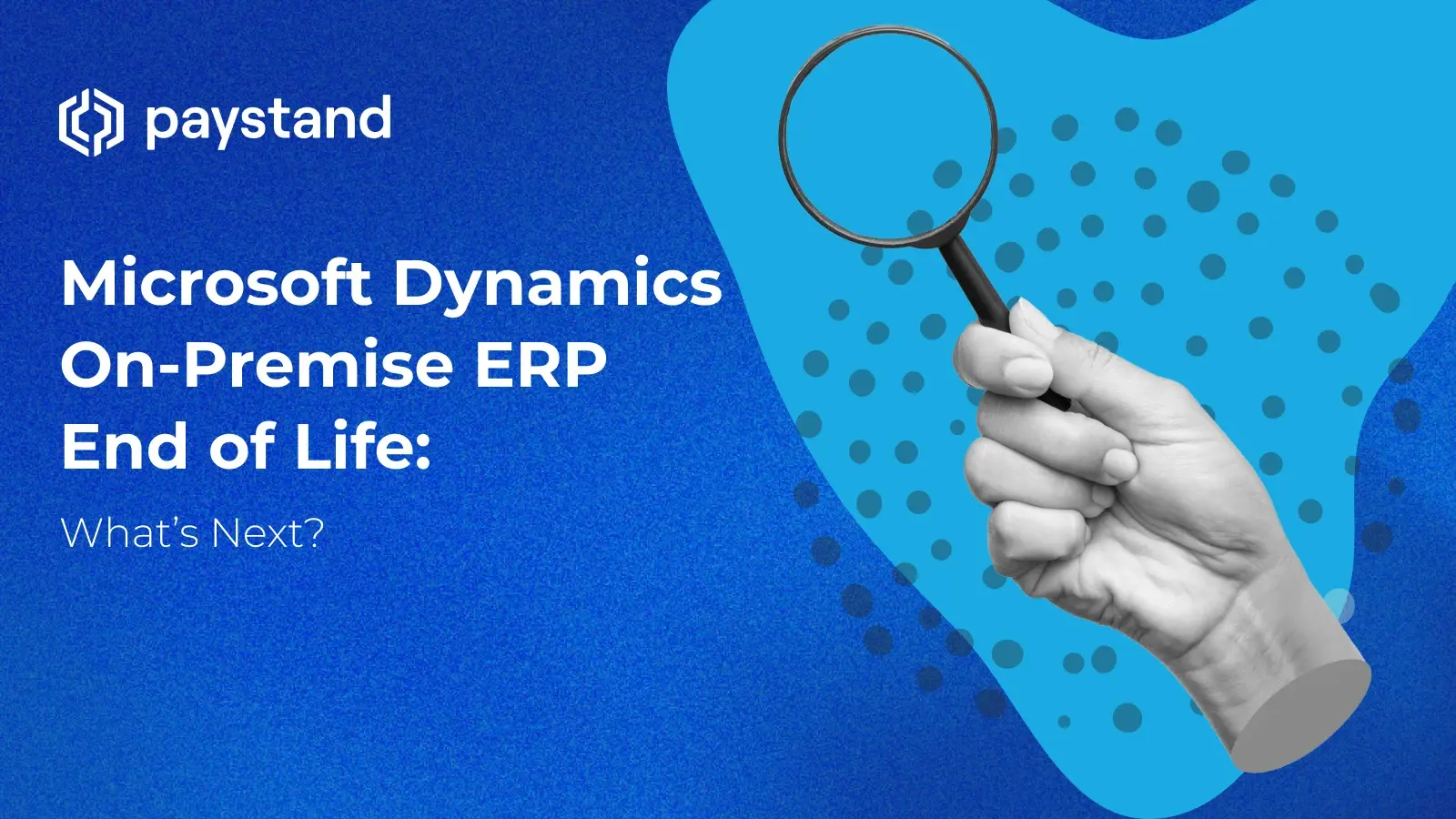Microsoft Dynamics On-Premise ERP End of Life: What’s Next?

Table of Contents
- Is Dynamics on-premise ERP ending soon?
- What happens when support ends?
- Should you upgrade or transition?
- Preparing for the end: strategic steps to take now
- Paystand: the future-proof finance platform
Key Takeaways
- Microsoft is phasing out its legacy on-premise Dynamics ERPs, such as GP, NAV, SL, and AX, and pushing businesses toward cloud-based Dynamics 365 Business Central.
- Relying on unsupported legacy systems increases cybersecurity risks, integration headaches, and compliance challenges as support ends and updates cease.
- Upgrading on-premise ERPs is a short-term fix. Modern finance requires cloud-native platforms that support automation, AI, and smart contract workflows.
- Now is the time to audit your ERP, identify gaps, and transition to future-ready systems beyond replicating old processes in the cloud.
- Paystand offers a blockchain-powered, fee-free alternative that integrates with Business Central to modernize AR, streamline payments, and eliminate manual work.
For decades, Microsoft Dynamics on-premise ERP systems like GP, NAV, SL, and AX were essential for enterprise finance, helping organizations consistently manage operations, supply chains, and business processes. However, Microsoft has announced clear end-of-support timelines for its legacy ERP platforms, forcing finance teams to adapt or fall behind.
Microsoft Dynamics GP and Dynamics 365 Finance + Operations (on-premises) are being phased out in favor of the cloud-based Microsoft Dynamics 365 Business Central. This move aligns with a broader economic and technological shift.
Digital transformation is essential, and legacy ERPs can't meet today’s demands of a decentralized, real-time, blockchain economy. If your team depends on outdated infrastructure, rethink the foundation of your financial strategy.
So, before we discuss what happens if your Dynamics ERP reaches its end of life, ask yourself: Are you building your business's future on a system that’s already fading into the past?
Is Dynamics On-Premise ERP Ending Soon?
Short answer: yes. While “soon” may vary depending on which product you’re using, the end is firmly in sight. Microsoft’s official product lifecycle indicates that mainstream support for Dynamics GP 2018 ends on January 14, 2025, with extended support continuing until April 30, 2028. For others, such as Dynamics SL and NAV, end-of-life deadlines are either already in place or not far off.
On-premises Dynamics 365 Finance + Operations deployments face challenges from Microsoft's modern lifecycle policy, which prioritizes agile, cloud-based upgrades and regular feature updates.
The main issue is that technical support and security updates cease once a product exits extended support, exposing you to legacy systems' vulnerabilities, compliance problems, and expensive workarounds. The message, "Access to this page requires authorization," means you're locked out of the future.
What Happens When Support Ends?
Without technical support and security updates, organizations face increased cybersecurity risks, incompatibilities with modern integrations, and a growing inability to meet evolving regulatory demands. Worse yet, supply chains and finance operations can become fragmented as old systems fail to keep up with new B2B payments infrastructure and AR automation in Business Central.
Don't forget: your IT team will spend more time maintaining legacy software that is becoming obsolete. In a blockchain, AI, and decentralized finance world, this is like plugging leaks in a sinking ship instead of building a new one.
Should You Upgrade or Transition?
Upgrading Dynamics isn't a long-term fix if kept on-premise. A better move is transitioning to cloud-native ERP systems, like Microsoft Dynamics 365 Business Central, which provide modern support and integration with technologies like ERP payments automation, AI forecasting, and smart contract workflows.
Considering Microsoft Dynamics 365 or newer SaaS platforms, flexibility is key. Cloud platforms offer continuous updates, aligning with your business growth, security needs, and fast-moving supply chain management.
Preparing for the End: Strategic Steps to Take Now
If your system’s sunset date is December 31, 2029, or January 14, 2025, don’t wait for the lights to go out. Audit your current version of Dynamics. Identify the features your team relies on and where you encounter issues: signing in, changing directories, being locked out of support portals, or battling data silos.
Then, explore alternatives to Dynamics on-premise ERP. Consider platforms that don’t just mimic old workflows in the cloud but fundamentally rethink how finance should operate in a digital-first world. That means platforms incorporating decentralized infrastructure, zero-touch payments, and real-time visibility into every transaction.
Paystand: The Future-Proof Finance Platform
That’s where Paystand steps in. Designed for a post-ERP, post-paper world, Paystand doesn’t just patch up the legacy issues of traditional financial systems; it eliminates them.
By integrating directly with Microsoft Dynamics 365 Business Central, Paystand enables seamless ERP payments, automates your accounts receivable, and taps into the power of blockchain and smart contracts to reduce friction, lower fees, and eliminate manual processes.
Here are just a few ways Paystand changes the game:
- No transaction fees: With Paystand’s flat-fee model, you escape the hidden costs baked into legacy payment rails.
- Smart B2B payments: Automate billing, collections, and reconciliation through embedded workflows in your ERP.
- Real-time data and insights: Gain total visibility into your cash flow with AI-driven dashboards.
- Zero-touch AR automation: Say goodbye to spreadsheets and hello to continuous, scalable processes.
- Decentralized ledgering: A blockchain-based payment network for speed, transparency, and security.
If you haven’t entered the new era of finance, now’s the moment. Because here’s the truth: Microsoft's ERP roadmap is leading away from on-premise.
Legacy systems aren’t just outdated; they’re holding your business back. Paystand is part of a new ecosystem that includes decentralized finance, cryptocurrency, smart contracts, and mission-driven fintech innovation.
So ask yourself: Are you optimizing for the past or building for the future? If you’re ready to challenge everything and make the switch that will define your business's next decade, start here.






